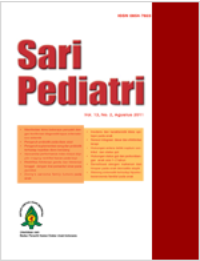Uji Diagnostik CD64 Netrofil untuk Sepsis pada Anak dengan Systemic Inflammatory Response Syndrome
Sari
Latar belakang. Sepsis merupakan salah satu penyebab utama mortalitas dan morbiditas pada anak. Diagnosis dini sepsis sangat penting untuk menghindari keterlambatan atau overtreatment pemberian antibiotik. Kultur darah memerlukan waktu yang lama sehingga dibutuhkan suatu marker yang bisa menentukan diagnosis sepsis secara dini.
Tujuan. Penelitian ini bertujuan untuk mengetahui peranan CD64 netrofil sebagai salah satu marker untuk deteksi dini sepsis.
Metode. Penelitian cross sectional dilakukan di IGD RS Dr. M. Djamil Padang. Dilakukan pemeriksaan index CD64 netrofil dan kultur bakteri darah sebagai baku emas pada anak dengan systemic inflammatory response syndrome (SIRS). Analisis stastistik dilakukan untuk menetapkan cut off point index CD64 netrofil untuk diagnosis sepsis.
Hasil. Rerata index CD64 netrofil lebih tinggi pada kultur bakteri darah yang positif. CD64 netrofil memiliki sensitivitas 95,8%, spesifisitas 81,6%, nilai prediksi positif 76,7%, dan nilai prediksi negatif 96,9% dengan penetapan cut-off point 1,5. Pada penelitian ini didapatkan nilai cut off point 1,49.
Kesimpulan. Indeks CD64 netrofil dapat digunakan sebagai parameter diagnostik pada sepsis. Nilai cut-off point index CD64 netrofil yang direkomendasikan sebagai batasan sepsis pada anak dengan SIRS adalah 1,49 atau 1,5.
Kata Kunci
Teks Lengkap:
PDFReferensi
Latief A, Chairulfatah A, Alam A, dkk, Diagnosis dan tata laksana sepsis pada anak. Jakarta: UKK ERIA dan UKK Infeksi dan Penyakit Tropik IDAI;2016.
Singer M, Deutschman CS, Seymour CW, dkk. The Third International Consensus Definitions for Sepsis and Septic Shock (Sepsis-3). JAMA 2016;315:801-10.
Dewi R. Sepsis pada anak : pola kuman dan uji kepekaan. Maj
Kedokt Indon 2011;61:101-6.
Souza D, Shieh HH, Troster EJ. Comparisons in the epidemiology and outcomes of pediatric septic patients admitted to public and private hospitals in Latin America. Pediatr Crit Care Med 2014;15:18-9.
Ruth A, McCracken CE, Fortenberry JD, dkk. Pediatric severe sepsis : current trends and outcomes from the pediatric health information systems database. Pediatr Crit Care Med 2014;15:828-38.
Weiss SL, Fitzgerald JC, Pappachan J, dkk. Global epidemiology of pediatric severe sepsis : the sepsis prevalence, outcomes, and therapies study. Am J Respir Crit Care Med 2015;191:1147-57.
Shime N, Kawasaki T, Saito O, dkk. Incidence and risk factors for mortality in paediatric severe sepsis : results from the national paediatric intensive care registry in Japan. Intensive Care Med 2012;38:1191-7.
Weiss SL, Fitzgerald JC, Balamuth F, dkk. Delayed antimicrobial therapy increases mortality and organ dysfunction duration in pediatric sepsis. Crit Care Med 2014;42:2409-17.
Venet F, Lepape A, Monneret G. Clinical review : flow citometry perspective in the ICU – from diagnosis of infection to monitoring of injury-induced immune dysfunctions. Crit Care 2011;231:1-9.
Khilnani P, Deopujari S, Carcillo J. Recent advances in sepsis
and septic shock. Indian J Pediatr 2008;75:821-30.
Allen E, Bakke AC, Purtzer MZ, Deodhar A. Neutrophil CD64 expression : distinguishing acute inflammatory autoimmune disease from systemic infections. Ann Rheum Dis 2002;61:522-25.
Chan T, Gu F. Early diagnosis of sepsis using serum biomarkers. Expert Rev Mol Diagn 2011;11:487-96.
Marraro GA. Pediatric sepsis : actions to decrease sepsis in children. Expert Rev Anti Infect Ther 2009;7:941-4.
Livaditi O, Kotanidou A, Psarra A. Neutrophil CD64 expression and serum IL-8: sensitive early markers of severity and outcome in sepsis. Cytokine 2006;36:283-90.
Davis B. Improved diagnostic approaches to infection/sepsis detection. Expert Rev Mol Diagn 2005;5:193-207.
Hoffman JJ. Neutrophil CD64: a diagnostic marker for infection and sepsis. Clin Chem Lab Med 2009;47:903-16.
Carvalho PRA, Feldens L, Seitz EE, Rocha T, Soledade M, Trotta A. Prevalence of systemic inflammatory syndromes at a
tertiary pediatric intensive care unit. J Pediatr 2005;81:143-48.
Pavare J, Grope I, Gardovska D. Prevalence of systemic inflammatory response syndroem (SIRS) in hospitalized children : a point prevalence study. BMC Pediatr 2009;9:25
Groselj-Grenj M, Ihan A, Derganc M. Neutrophil and monocyte CD64 and CD163 expression in critically ill neonates and children with sepsis : comparison of fluorescence intensities and calculated indexes. Hindawi Publish Corp Mediat Inflamm 2008;1:1-6.
Stubljar D, Skvarc M. Expression of CD64 on neutrophils can be used to predict the severity of bloodstream infection before broad range 16S rRNA PCR. Folia Microbiol 2014;1:1-8.
Grey D, Sack U, Scholz M, dkk. Increased CD64 expression on polymorphonuclear neutrophils indicates infectious complications following solid organ transplantation. Cytometry Part A 2011;79:446-60.
Icardi M, Erickson Y, Kilborn S, Stewart B, Grief B, Schamweber G. CD64 provides simple and predictive testing for detection and monitoring of sepsis and bacterial infection in hospital patients. J Clin Microbiol 2009;47:3914-9.
Dhlamini MB, Suchard MS, Wiggill TM, Fadahun OO, Ballot DE. Neutrophil CD64 has a high negative predictive value for exclusion of neonatal sepsis. South African J Child Health 2013;7:25-9.
Cid J, Aguinaco R, Sanchez R, Garcia-Pardo G, Liorente A. Neutrophil CD64 expression as marker of bacterial infection : a
systematic review and meta analysis. Jof Infect 2010;60:313-9.
Li S, Huang X, Chen Z. Neutrophil CD64 expression as a biomarker in the early diagnosis of bacterial infection: a metaanalysis.
Int J Infect Dis 2013;17:e12-23.
Mirrett S, Reller LB, Weinstein MP. Controlled clinical comparison of BacT/ALERT standard aerobic medium with BACTEC standard aerobic medium for culturing blood. J Clin Microbiol 2003;41:2391-4.
Horvath LL, George BJ, Hospenthal DR. Direct comparison of the BACTEC 9240 and BacT/ALERT 3D automated blood culture systems for candida growth detection. J Clin Microbiol 2004;42:115-8.
DOI: http://dx.doi.org/10.14238/sp20.2.2018.79-84
Refbacks
- Saat ini tidak ada refbacks.
##submission.copyrightStatement##
##submission.license.cc.by-nc-sa4.footer##
Email: editorial [at] saripediatri.org


Sari Pediatri diterbitkan oleh Badan Penerbit Ikatan Dokter Anak Indonesia
Ciptaan disebarluaskan di bawah Lisensi Creative Commons Atribusi-NonKomersial-BerbagiSerupa 4.0 Internasional.




